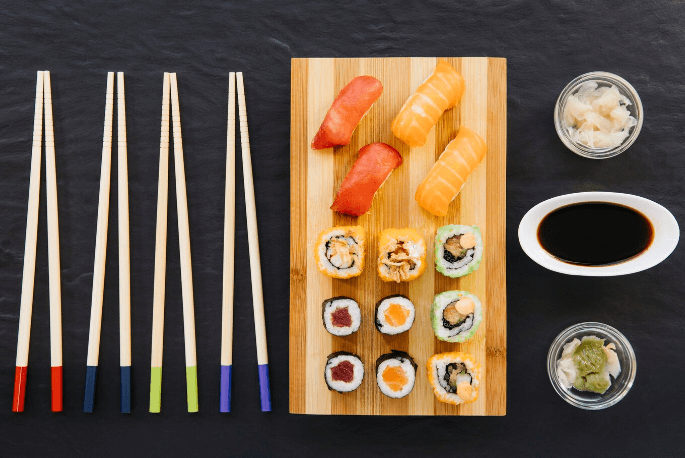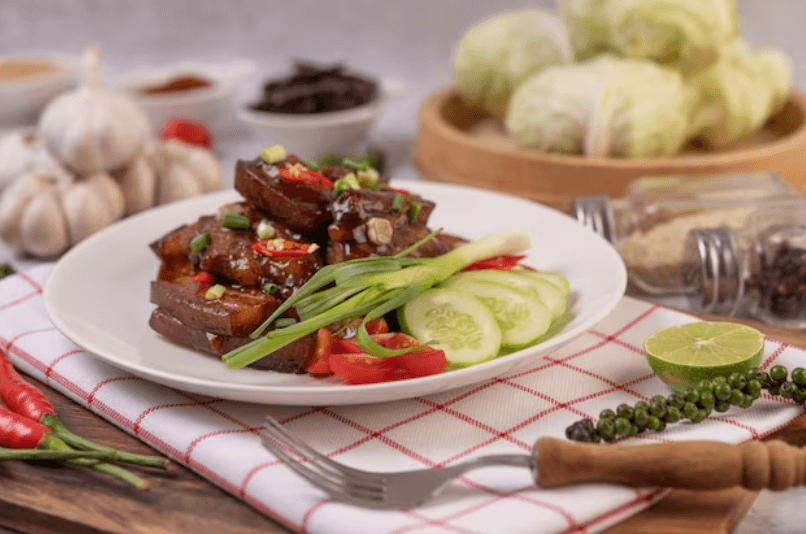What Is the Hamachi Sushi?

Are you a sushi lover who is always on the lookout for new and exciting types of sushi? If so, then you need to try Hamachi Sushi! This delicious delicacy is made from fresh and succulent Yellowtail fish, known as Hamachi in Japanese. With its unique flavor profile, rich texture, and numerous health benefits, it’s no wonder why this traditional sushi type has been gaining popularity among food enthusiasts worldwide. In this blog post, we will explore everything there is to know about Hamachi Sushi – from its origins to how to prepare it at home. So sit back, grab your chopsticks and get ready to dive into the world of Hamachi Sushi!
What Is the Hamachi Sushi?
If you’re a sushi lover, then you might have heard of Hamachi Sushi. But if you haven’t, don’t worry! In this blog post, we’ll introduce you to Hamachi Sushi and everything you need to know about it.
Hamachi Sushi is a popular type of traditional Japanese sushi that features the high-quality flesh of yellowtail fish. The term “”hamachi”” actually refers to yellowtail tuna or amberjack fish in Japan.
The origins of Hamachi Sushi can be traced back hundreds of years ago when fishermen started using yellowtail as a main ingredient for their meals. Over time, chefs began experimenting with different ways to prepare the fish and eventually found that it tasted amazing when paired with rice and other ingredients like avocado or cucumber.
Today, Hamachi Sushi remains one of the most sought-after types among sushi lovers worldwide due to its unique taste profile and texture.
Want to learn more about the taste profile and nutritional benefits of hamachi? Keep reading our blog post!
The Origins of Hamachi Sushi
The origins of Hamachi Sushi can be traced back to Japan, where sushi has been a staple food for centuries. The term “”sushi”” actually refers to the vinegared rice used in the dish, and not necessarily the raw fish that is commonly associated with it.
Hamachi, which translates to “”yellowtail”” in Japanese, is a popular choice for sushi because of its rich flavor and buttery texture. It’s believed that Hamachi first became popular as sushi during the Edo period in Japan (1603-1868), when advancements in fishing technology made it easier to catch larger fish like yellowtail.
Today, Hamachi Sushi can be found on menus all over the world and has become a favorite among sushi enthusiasts. However, it’s important to note that not all yellowtail used for sushi is actually Hamachi – sometimes other species of yellowtail are substituted due to availability or cost.
Despite this potential issue, true Hamachi Sushi remains a beloved delicacy among those who appreciate its unique taste and history within Japanese cuisine.
What is Hamachi?
Hamachi is a type of fish that is commonly used in sushi. It belongs to the family Seriolidae and is also known as yellowtail or Japanese amberjack. Hamachi fish are usually caught in the Pacific Ocean, particularly off the coast of Japan.
The flesh of hamachi is firm and buttery with a mild flavor that can be described as slightly sweet, nutty, and savory. This makes it an ideal ingredient for sushi rolls, sashimi, and other raw preparations.
The texture of hamachi meat varies depending on its fat content. The more fat it has, the smoother and creamier its texture becomes. This characteristic makes it melt in your mouth when eaten raw or lightly seared.
Aside from being deliciously tasty, hamachi offers several health benefits too. It’s loaded with omega-3 fatty acids which help reduce inflammation throughout the body while benefiting brain function and heart health.
Hamachi’s unique taste profile coupled with its nutritional value make it a highly sought-after ingredient among sushi enthusiasts worldwide!
Understanding Hamachi Fish
Hamachi fish, also known as yellowtail or Japanese amberjack, is a popular type of fish used in sushi dishes. It belongs to the jack family and can be found in Pacific waters from Japan to Hawaii.
This fish has a sleek body that’s perfect for swimming at high speeds, which makes it a challenging catch for fishermen. Hamachi is typically harvested when it reaches about 20 pounds in weight and can grow up to 200 pounds.
The flavor profile of hamachi is rich and buttery with a slight sweetness that pairs perfectly with rice and other sushi ingredients. When selecting hamachi for your dish, look for firm flesh that’s glossy with no discoloration or blemishes.
One key thing to note about this fish is that it contains higher levels of mercury compared to other types of seafood. It’s important to consume hamachi in moderation if you are pregnant or have health concerns related to mercury exposure.
Understanding the unique characteristics of hamachi will help you appreciate its taste and make more informed decisions when selecting seafood options for your meals.
Harvesting and Seasonality of Hamachi
Hamachi fish is harvested year-round in Japan, but the peak season for its catch runs from late autumn through winter. During this time, when the waters are colder and deeper, Hamachi fish have a higher fat content which makes them more flavorful and rich.
There are two main methods of harvesting Hamachi: farm-raised or wild-caught. Farmed Hamachi is typically available throughout the year because it is grown in controlled environments that can be manipulated to suit their growth needs. Meanwhile, wild-caught Hamachi tends to be more seasonal as it depends on fishing conditions such as weather patterns and migration habits.
The sustainability of Hamachi farming has become a subject of concern due to high demand for it worldwide. However, sustainable aquaculture practices such as limiting stocking densities and using eco-friendly feeds are being adopted by some producers to minimize negative impacts on marine ecosystems and promote long-term sustainability.
Understanding the harvesting and seasonality of Hamachi plays an important role in enjoying its flavor at its best while also supporting ethical practices in seafood sourcing.
The Taste Profile of Hamachi Sushi
When it comes to sushi, the taste of Hamachi is one that stands out. This fish has a mild and rich flavor that makes it popular among seafood lovers. The texture of the fish also contributes to its unique taste profile.
Hamachi sushi offers a buttery and creamy mouthfeel with an almost nutty flavor that pairs well with soy sauce or wasabi. Its subtle salty and umami flavors provide a delightful balance when combined with other ingredients in sushi rolls such as avocado, cucumber, or seaweed.
The yellowtail’s flesh has just enough fat content to offer richness without being too oily or greasy. It’s this characteristic that makes Hamachi stand out from other types of fish used in traditional sushi.
While some might find raw fish unappetizing, others appreciate the delicate and light taste of Hamachi compared to cooked versions like salmon or tuna which can have a more intense flavor profile.
If you’re looking for something different but still packed full of flavour when it comes to your next plate of Sushi – be sure not miss trying out some delicious Hamachi!
Flavor and Texture
Hamachi Sushi is a delicate dish with complex flavor and texture profiles. The combination of the fish’s buttery and mild taste, along with the contrasting crunchiness of vegetables or creaminess from avocado creates an unforgettable experience for sushi enthusiasts.
The texture of Hamachi Fish itself is firmer than other types of raw fish used in sushi, such as salmon or tuna. It has a pleasant chewiness that makes it stand out among other choices on the menu. The fat content within hamachi gives it its uniquely smooth mouthfeel which complements its taste profile perfectly.
When paired with rice seasoned with vinegar, soy sauce and wasabi, each bite becomes a symphony of flavors that burst in your mouth. It’s no wonder why Hamachi Sushi ranks highly among traditional sushi options thanks to its unique blend of subtle tastes and textures.
In addition to being delicious, Hamachi Sushi also offers many health benefits due to high levels of Omega-3 fatty acids and protein content found within the fish meat. These nutrients can help boost one’s overall well-being while satisfying their cravings for a decadent culinary treat at the same time.
If you’re looking for something different from traditional sushi but still want all those delightful Japanese flavors – try some Hamachi Sushi!
Nutritional Benefits of Hamachi Sushi
Hamachi Sushi not only tastes great but it also has numerous health benefits. Hamachi is rich in omega-3 fatty acids which are essential for brain function and heart health. Omega-3s also have anti-inflammatory properties that can help reduce the risk of chronic diseases such as arthritis, cancer, and cardiovascular disease.
Additionally, hamachi fish is high in protein which helps to promote satiety and build muscle mass. It contains a range of vitamins including vitamin D which plays an important role in bone strength and immune function.
Moreover, hamachi sushi doesn’t contain any carbohydrates or added sugar making it a great low-calorie option for those looking to maintain their weight or lose weight. The seaweed wrap used in sushi rolls also provides fiber which aids digestion and promotes gut health.
It’s worth noting that while consuming raw fish carries some risk of foodborne illness, reputable sushi restaurants take precautions to ensure the safety of their customers by using fresh fish from trusted sources and properly storing it at safe temperatures.
Adding hamachi sushi to your diet can provide numerous nutritional benefits along with a delicious dining experience.
Preparing Hamachi Sushi at Home
Making your own Hamachi sushi at home can be a fun and rewarding experience. However, it’s important to ensure that you handle the fish properly to avoid any risk of contamination or illness.
Firstly, make sure you purchase high-quality fresh Hamachi from a reputable supplier. It’s also recommended to freeze the fish for at least 24 hours before consuming raw in order to kill any parasites.
Next, prepare your sushi rice according to its package instructions. Once cooked, season with vinegar and sugar and allow it to cool slightly before handling.
To assemble the sushi rolls, place a sheet of nori on top of your rolling mat with the shiny side facing down. Spread a thin layer of rice over two-thirds of the nori sheet then add thinly sliced pieces of Hamachi on top.
Using your mat to help guide you, carefully roll up the sushi. Repeat this process until all ingredients are used up.
Use a sharp knife dampened with water or vinegar to slice the rolls into bite-sized pieces and serve alongside soy sauce and wasabi for dipping.
Step-by-Step Hamachi Sushi Recipe
Making your own sushi can be a fun and rewarding experience, especially when you get to enjoy the delicious taste of Hamachi Sushi. Here is a step-by-step recipe for making this traditional Japanese dish at home.
Start by preparing the sushi rice according to the instructions on the package. While the rice is cooking, slice your hamachi into thin strips and set it aside.
Once your rice is cooked, add in vinegar, sugar, and salt to create sushi rice seasoning. Then spread out the cooked rice onto a flat surface like a baking sheet or large bowl.
Next, cover with plastic wrap and let it cool down before spreading some wasabi paste over each piece of hamachi strip.
Grab a bamboo mat covered in plastic wrap for rolling up your sushi pieces. Place one nori sheet shiny side down on top of the mat then wet your hands with water to help prevent sticking while handling food.
Spread an even layer of seasoned sushi rice over half of nori sheet closest to you leaving about 1 inch (2cm) from edge without any toppings or sauce yet applied – otherwise it will become too soggy during rolling process!
Place sliced hamachi fish on top tightly so that they don’t fall off later while rolling everything up together neatly using gentle pressure starting from end closest towards yourself until all ingredients are rolled up perfectly inside seaweed wrapper forming cylinder-shaped rolls!
With these simple steps, you can now enjoy delicious Hamachi Sushi right at home!
Tips for Enjoying Hamachi Sushi
If you’re a fan of sushi, then there’s no doubt that you’ve tried Hamachi Sushi at some point. This delicious and healthy dish is enjoyed by people all over the world, but there are a few tips to keep in mind if you really want to enjoy it.
Firstly, be sure to eat your Hamachi Sushi with wasabi and soy sauce. These condiments will enhance the flavor of the fish and give it an extra kick that you won’t get without them.
Another tip is to eat your sushi in one bite. Many people make the mistake of trying to cut their sushi into smaller pieces or taking small bites. However, this can cause the flavors and textures to become muddled together and diminishes the overall experience.
It’s also important to appreciate the simplicity of Hamachi Sushi. Unlike other types of sushi which may have several ingredients combined together, Hamachi Sushi only features one key ingredient – hamachi fish. By focusing on its natural flavors, you’ll discover that less really can be more!
Remember that enjoying any type of sushi requires patience and mindfulness – take time to savor each bite rather than rushing through your meal!
Where to Find the Best Hamachi Sushi
If you’re looking for the best hamachi sushi in town, your options may be limited depending on where you live. However, most cities have at least a few good sushi restaurants that serve fresh and delicious hamachi.
One way to find the best hamachi sushi is by reading online reviews. Websites like Yelp or Google Reviews can provide insight into the quality of food and service at various restaurants. Look for places with high ratings and positive comments specifically mentioning their hamachi sushi dishes.
Another option is to ask friends or family members who enjoy sushi for recommendations. They may have tried some exceptional hamachi dishes in their favorite restaurants and can offer valuable advice based on personal experience.
You could also try visiting different sushi spots in your area until you find one that serves great-tasting hamachi. Don’t hesitate to ask the chef if they use fresh ingredients, as this can make all the difference when it comes to taste.
Remember that finding the best hamachi sushi requires patience and persistence – but once you do discover it, your taste buds will thank you!
Other Popular Types of Sushi
Apart from Hamachi Sushi, there are many other popular types of sushi that you can try. Each type has its unique flavor and texture profile.
One of the most common types is Nigiri, which consists of a small ball of rice topped with various seafood or vegetables. Another popular option is Maki rolls, which features seaweed wrapped around rice and fillings like fish or avocado.
Temaki hand rolls are also trendy as they offer a fun twist to traditional sushi by being cone-shaped instead of rolled. For those who love fried food, Tempura sushi is an excellent choice as it features battered and deep-fried shrimp or vegetables.
Sashimi is another type that doesn’t involve any rice at all. It’s simply thin slices of raw fish served on their own with soy sauce and wasabi for dipping.
If you’re feeling adventurous, you can also try more unusual options such as Uni (sea urchin) or Ikura (salmon roe). Whatever your taste preferences may be, there’s always something new to discover in the world of sushi!
Comparison of Hamachi Sushi with Other Types
When it comes to sushi, there are many different types available. From the traditional tuna and salmon rolls to more exotic options like sea urchin or eel, there is truly something for everyone. One type of sushi that has been growing in popularity over recent years is hamachi sushi.
So how does hamachi compare to other popular types of sushi? Well, for starters, hamachi has a much milder taste than some other fish used in sushi. While some people love the strong flavor of tuna or salmon, others may find them too overwhelming. Hamachi offers a nice balance with its subtle yet distinct taste.
In terms of texture, hamachi is also unique compared to other types of fish commonly used in sushi. Its flesh is firm yet buttery and melts in your mouth with each bite. This makes it an excellent choice for those who prefer less chewy textures.
Another factor that sets hamachi apart from other types of sushi is its nutritional benefits. It’s high in protein and omega-3 fatty acids while being low in calories and fat content – making it a great option for anyone looking for healthier meal choices.
While every type of sushi has its own unique qualities and flavors that make them special, there’s no denying that hamachi stands out among the crowd as an excellent choice worth trying!
Conclusion
Hamachi sushi is a delicious and nutritious type of traditional sushi that has been enjoyed for centuries. It has a unique flavor profile and texture that sets it apart from other types of sushi. Understanding the origins, harvesting, seasonality, and nutritional benefits of Hamachi fish can help you appreciate this delicacy even more.
With the step-by-step recipe provided in this article, you can also try making your own Hamachi sushi at home. Remember to use only fresh ingredients and follow proper food safety procedures when preparing raw fish.
Whether you prefer to dine out or make your own at home, there are plenty of options for enjoying Hamachi sushi. And with its growing popularity around the world, you can easily find top-quality restaurants that serve this delectable dish.
So why not give it a try? Expand your palate by experiencing the flavors and textures of one of Japan’s most beloved culinary traditions – Hamachi Sushi!





